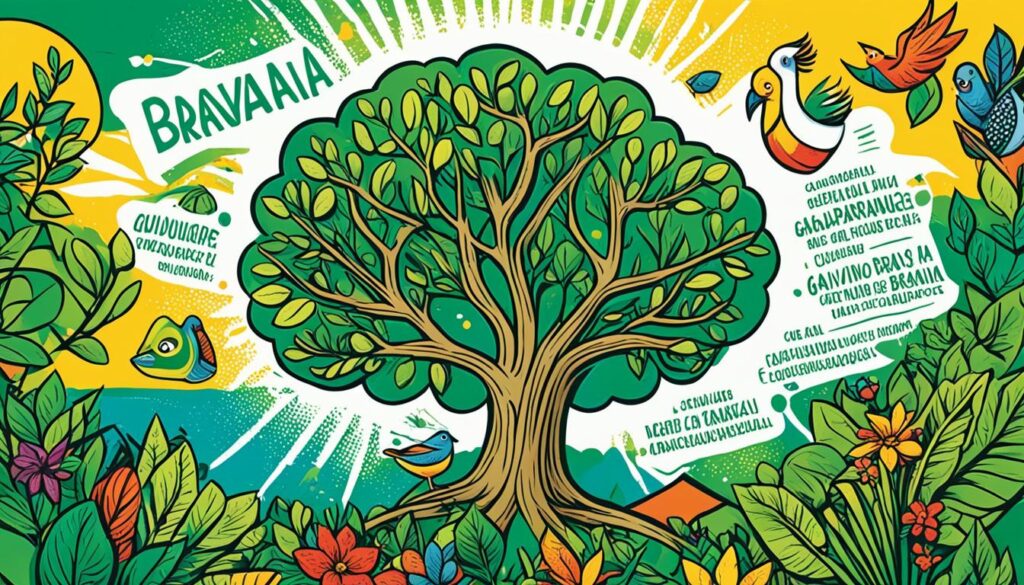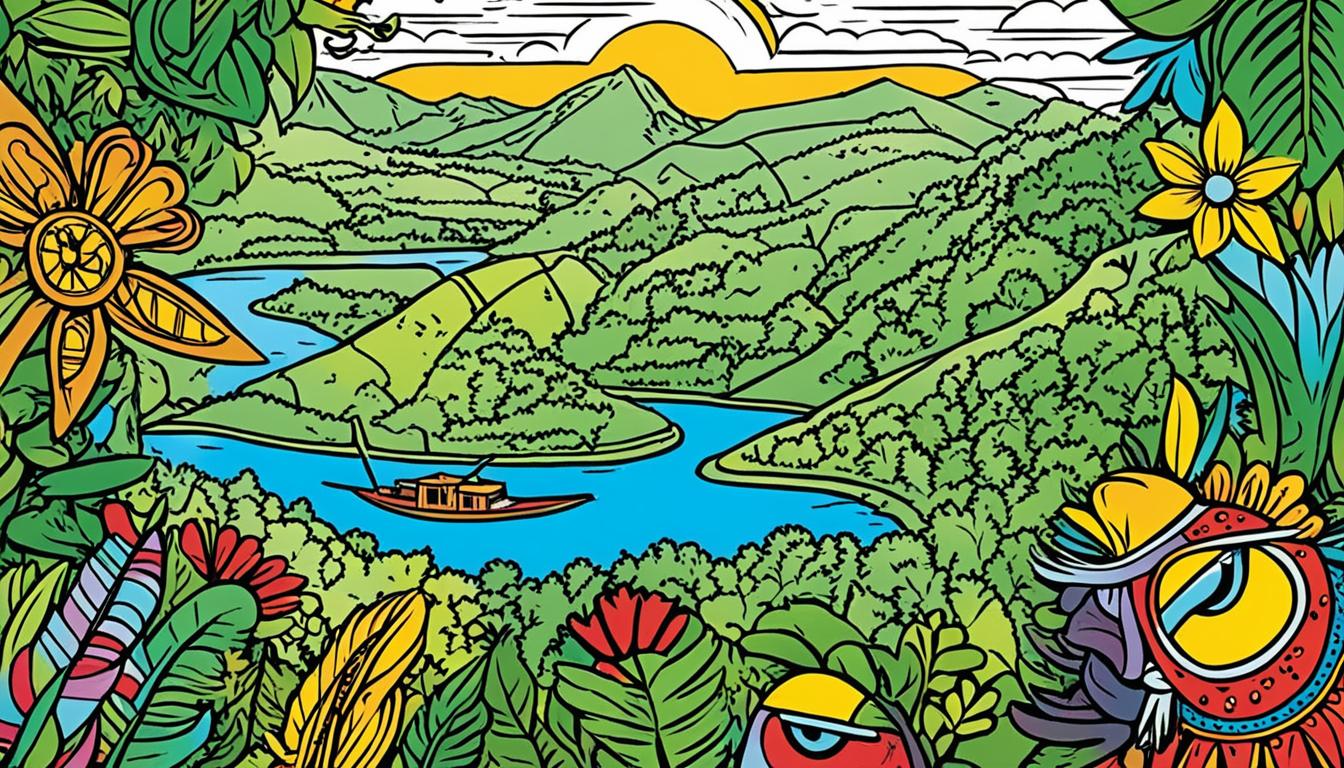Did you know that the Gavião do Jiparaná language, spoken by the Gavião tribe in Rondônia, Brazil, is classified as endangered? With an estimated 340 native speakers as of 2006, this indigenous language is at risk of disappearing. Its preservation and revitalization are crucial for the linguistic diversity and cultural heritage of Brazil’s indigenous tribes.
In this article, we will explore the Gavião do Jiparaná language, its unique features, the challenges it faces, and the efforts being made for its revitalization. We will also highlight the importance of linguistic diversity and the role it plays in preserving indigenous knowledge and traditions. Join us as we delve into the fascinating world of Gavião do Jiparaná and its significance for Brazil’s linguistic heritage.
Overview of the Gavião do Jiparaná Language
The Gavião do Jiparaná language is a tonal language with an SOV (subject-object-verb) word order. It is primarily spoken by the Gavião tribe in Rondônia, Brazil. The language is part of the larger family of South American languages and belongs to the Monde branch of the Tupian language family. The Gavião do Jiparaná language has its own unique linguistic features and is partially intelligible with the Suruí language.
The Gavião do Jiparaná language, spoken by the Gavião tribe in Rondônia, Brazil, is a tonal language with an SOV (subject-object-verb) word order. It belongs to the Monde branch of the Tupian language family, which is a part of the larger family of South American languages. Although it has its own distinct linguistic features, the Gavião do Jiparaná language shares partial intelligibility with the Suruí language.
Endangered Status and Challenges
Like many indigenous languages, the Gavião do Jiparaná language is considered endangered. With only 340 native speakers as of 2006, the language faces various challenges to its preservation and revitalization. These challenges include language shift towards Portuguese, the dominant language in Brazil, as well as socio-cultural changes and limited intergenerational transmission of the language.
The dominant language shift towards Portuguese poses a significant threat to the Gavião do Jiparaná language. As indigenous communities adapt to a modernized society, younger generations often prioritize learning Portuguese, leading to a decrease in the usage and fluency of their native language. This language shift erodes the linguistic foundation of the Gavião do Jiparaná community and further contributes to the endangerment of their language.
Additionally, socio-cultural changes and external influences impact the vitality of the Gavião do Jiparaná language. Urbanization, globalization, and cultural assimilation diminish the use and importance of indigenous languages within the community. As traditional practices and customs evolve, the need to communicate efficiently in the dominant language supersedes the continuation of indigenous languages such as Gavião do Jiparaná.
Furthermore, limited intergenerational transmission of the language hinders its revitalization. The younger generation, often raised in predominantly Portuguese-speaking environments, may not have the same exposure to the Gavião do Jiparaná language as their elders. Without comprehensive opportunities for language transmission and preservation, the language struggles to thrive and risks further marginalization.
Efforts are being made to address these challenges and support the revitalization of endangered languages like Gavião do Jiparaná. Organizations, indigenous communities, and linguists are working together to raise awareness about the importance of language preservation and to develop strategies to promote indigenous language revitalization.
“Preserving the linguistic diversity and cultural heritage of indigenous communities is crucial for maintaining their identity and preserving their knowledge. The revitalization of endangered languages like Gavião do Jiparaná is not only a linguistic matter but also a matter of cultural rights and social justice.”
By promoting language preservation and providing resources and support for indigenous language revitalization, we can help safeguard the linguistic heritage of communities like the Gavião do Jiparaná, ensuring the survival and continued development of their unique languages.
Importance of Linguistic Diversity
The Gavião do Jiparaná language is a valuable component of Brazil’s linguistic diversity, which is an essential part of the country’s cultural heritage. Linguistic diversity plays a crucial role in preserving indigenous knowledge, traditions, and cultural practices. It also contributes to a deeper understanding of human communication and cognition. Recognizing and supporting linguistic diversity is vital for safeguarding the collective memory and identity of indigenous communities.
The Cultural Heritage of Linguistic Diversity
Linguistic diversity offers a rich tapestry of cultural heritage, reflecting the distinct ways in which different communities perceive and interact with the world. Each language holds a unique set of words, expressions, and concepts that encapsulate the particular traditions, rituals, and beliefs of a community. By preserving and promoting linguistic diversity, we ensure that these valuable cultural aspects can be passed down to future generations.
Preserving Indigenous Knowledge and Traditions
Indigenous languages, such as Gavião do Jiparaná, embody the deep-rooted knowledge and wisdom of indigenous communities. They carry within them traditional ecological knowledge, medicinal practices, storytelling traditions, and ancestral connections to the land. Preserving these languages is not only essential for the communities themselves but also for society as a whole, as it allows us to learn from and integrate indigenous knowledge into various fields, from environmental conservation to sustainable practices.
Enhancing Communication and Cognition
Linguistic diversity provides valuable insights into the complexity and variation of human communication and cognition. Each language offers a unique perspective on how individuals conceptualize and express their lived experiences. By studying different languages, we gain a deeper understanding of the intricacies of human language and its influence on thought processes, cultural norms, and social dynamics.
“Language is the road map of a culture. It tells you where its people come from and where they are going.”
– Rita Mae Brown
The Role of Indigenous Languages in Cultural Identity
Indigenous languages are intrinsically tied to the cultural identity of indigenous communities. They are integral to the expression of cultural values, beliefs, and practices. Preserving and revitalizing indigenous languages like Gavião do Jiparaná is crucial for upholding the rights and self-determination of indigenous peoples, allowing them to maintain a strong sense of connection to their heritage and fostering cultural pride.
Supporting Linguistic Diversity for a Brighter Future
Recognizing the importance of linguistic diversity is not only a matter of cultural preservation but also a commitment to social justice and inclusivity. Supporting initiatives that promote the revitalization and preservation of indigenous languages, such as Gavião do Jiparaná, ensures that linguistic diversity continues to thrive, empowering communities to preserve their cultural heritage and contribute to the rich tapestry of humanity’s collective knowledge.

Efforts for Revitalization
Various initiatives are underway to revitalize the Gavião do Jiparaná language. Language documentation projects have been conducted to record and analyze the linguistic features, vocabulary, and grammar of the language. These initiatives aim to develop educational materials, language resources, and language learning programs to support the Gavião community in preserving and revitalizing their language. Community-led efforts, such as language immersion programs and intergenerational language transmission, are also crucial for the revitalization process.
One such initiative is the Gavião do Jiparaná Language Documentation and Revitalization Project. This project involves linguists, anthropologists, and members of the Gavião community working together to document and study the language. The project focuses on creating a comprehensive language corpus, which includes audio recordings, written texts, and linguistic analyses. These resources will serve as a valuable reference for future language revitalization efforts.
The Gavião community has also taken an active role in the revitalization process by organizing language immersion programs. These programs provide opportunities for community members of all ages to engage in intensive language learning and practice. Through immersion in everyday activities, such as storytelling, cooking, and traditional crafts, participants can develop their language skills and strengthen their cultural identity.
Intergenerational language transmission is another essential aspect of the revitalization efforts. The Gavião elders play a crucial role in passing on the language to younger generations. They serve as language mentors, sharing their knowledge and experiences with the younger members of the community. Language revitalization programs often involve intergenerational language workshops and events, fostering a sense of pride and belonging among the Gavião people.
| Initiative | Description |
|---|---|
| Language Documentation Project | Recording and analyzing the linguistic features, vocabulary, and grammar of the Gavião do Jiparaná language |
| Educational Materials Development | Creating resources such as textbooks, dictionaries, and language learning materials for the Gavião community |
| Language Immersion Programs | Organizing immersion programs to provide intensive language learning and cultural experiences for community members |
| Intergenerational Language Transmission | Involving Gavião elders in passing on the language to younger generations through mentorship and workshops |
Indigenous Language Preservation in Brazil
The preservation of indigenous languages, like Gavião do Jiparaná, is a key aspect of Brazil’s language policy and cultural rights. The Brazilian government recognizes the importance of linguistic diversity and has implemented measures to support the preservation and revitalization of indigenous languages.
- Creation of language revitalization programs
- Promotion of bilingual education
- Recognition of indigenous cultural and linguistic rights
Collaboration between indigenous communities, linguists, educators, and policymakers is essential for successful language preservation initiatives. By working together, they can ensure the protection and revitalization of indigenous languages, safeguarding the cultural heritage and linguistic rights of Brazil’s indigenous communities.

Conclusion
The Gavião do Jiparaná Language holds immense significance as a part of Brazil’s linguistic heritage. Although it is an endangered language, efforts are underway to preserve and revitalize it. Through raising awareness, documenting the language, and supporting community-led initiatives, we can contribute to the revitalization of indigenous languages like Gavião do Jiparaná.
The preservation of linguistic diversity is vital, as it not only safeguards the cultural and linguistic rights of indigenous communities but also preserves their collective memory and identity. By recognizing and working towards the preservation of languages like Gavião do Jiparaná, we can ensure the cultural richness of Brazil’s indigenous tribes for future generations.
Supporting language revitalization programs, promoting bilingual education, and recognizing the cultural and linguistic rights of indigenous communities are essential steps in preserving Brazil’s linguistic heritage. Collaboration between indigenous communities, linguists, educators, and policymakers is crucial for the success of these initiatives.
FAQ
What is the Gavião do Jiparaná language?
The Gavião do Jiparaná language, also known as Gaviao do Jiparana or Gavião do Rondônia, is a Tupian language spoken by the Gavião tribe in Rondônia, Brazil.
How many native speakers does the Gavião do Jiparaná language have?
As of 2006, the Gavião do Jiparaná language has an estimated 340 native speakers.
Is the Gavião do Jiparaná language endangered?
Yes, the Gavião do Jiparaná language is classified as endangered.
What language family does the Gavião do Jiparaná language belong to?
The Gavião do Jiparaná language belongs to the Monde branch of the Tupian language family, which is part of the larger family of South American languages.
What are the challenges faced by the Gavião do Jiparaná language for its preservation?
The challenges faced by the Gavião do Jiparaná language include language shift towards Portuguese, socio-cultural changes, and limited intergenerational transmission.
Why is linguistic diversity important?
Linguistic diversity is important because it preserves indigenous knowledge, traditions, and cultural practices. It also contributes to a deeper understanding of human communication and cognition.
What efforts are being made for the revitalization of the Gavião do Jiparaná language?
Efforts for the revitalization of the Gavião do Jiparaná language include language documentation projects, development of educational materials and resources, and community-led initiatives such as language immersion programs.
How does Brazil support indigenous language preservation?
Brazil supports indigenous language preservation through the creation of language revitalization programs, promotion of bilingual education, and recognition of indigenous cultural and linguistic rights.
Why is the preservation of the Gavião do Jiparaná language important?
The Gavião do Jiparaná language is an important component of Brazil’s linguistic heritage. By preserving it, we safeguard the cultural and linguistic rights of indigenous communities and contribute to Brazil’s linguistic diversity.
